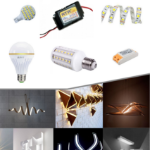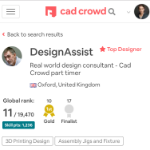All inventors would be happy to hear if their new ideas attached with some rudimentary sketches and necessary annotations from notebook are not only quickly granted patent rights but also are attractive enough for manufacturers and consumers to place orders. The bad news is that the process will not be that easy. Soon after you’ve completed the brainstorming process to compile those ideas and make notes about them, you will discover that many financial investments need to be made. In addition to patent rights, you may have to hire some professionals, such as 3D CAD designers, to come up with a digital prototype. Unless you already have a factory that deals with custom manufacturing, chances are you also must pay for the CAD services of prototype developers.



 Let us assume that all the ideas you have are indeed your own; you came up with the concept and developed it further. After a few months, you have many pages of notes and basic drawings to describe the product. Your notes can include information about the specifications and parameters that you want to implement, and the drawings give clear images of the product from various angles. The shape, textures, colors, features, functions, materials, and all related details are clearly stated in an organized way. All of those details are free except for probably $20 to purchase the inventor’s notebook, pencils, and a set of color markers. To build a physical prototype of the described product, however, there are some more steps to go through, and almost all of them require financial investments as follows.
Let us assume that all the ideas you have are indeed your own; you came up with the concept and developed it further. After a few months, you have many pages of notes and basic drawings to describe the product. Your notes can include information about the specifications and parameters that you want to implement, and the drawings give clear images of the product from various angles. The shape, textures, colors, features, functions, materials, and all related details are clearly stated in an organized way. All of those details are free except for probably $20 to purchase the inventor’s notebook, pencils, and a set of color markers. To build a physical prototype of the described product, however, there are some more steps to go through, and almost all of them require financial investments as follows.
Building Your Prototype
If your product design does not require a patent, you will need considerably less financial investment to build a prototype. Depending on the type of idea or product you have, sometimes it is only necessary to make a digital prototype. But then, there is no real physical artifact. But through a well-designed virtual image that is hyper-realistic and interactive that companies and investors might be able to decide if your ideas are technically feasible if they have the manufacturing capabilities to mass-produce your products. In general, there are three steps:



 1. Find 3D CAD Designers: You can quickly find a good number of reputable 3D CAD designers online, including our community of vetted CAD service experts. In addition to our service, you can also find many legitimate (and illegitimate) design firms with a quick search on Google. Do not settle with the first few names you see; make time to visit their websites and to read customer testimonials. There are no standard fees, which means the cost of creating the digital product prototype will vary greatly between companies. A high price ideally translates to quality service, but the price is not generally the best way to judge a design firm. Read general information about each agency’s location, return policy, guarantees, revisions, and terms related to protecting your ideas/designs.
1. Find 3D CAD Designers: You can quickly find a good number of reputable 3D CAD designers online, including our community of vetted CAD service experts. In addition to our service, you can also find many legitimate (and illegitimate) design firms with a quick search on Google. Do not settle with the first few names you see; make time to visit their websites and to read customer testimonials. There are no standard fees, which means the cost of creating the digital product prototype will vary greatly between companies. A high price ideally translates to quality service, but the price is not generally the best way to judge a design firm. Read general information about each agency’s location, return policy, guarantees, revisions, and terms related to protecting your ideas/designs.



 2. Sign an NDA (non-disclosure agreement): even if the 3D CAD designer promises to keep your designs and ideas secret, do not take their word for it. Always enforce a legally binding non-disclosure agreement. You are not legally required to hire a lawyer to draft and sign the agreement, but there are always risks of loopholes. If you cannot hire an attorney for the specific agreement, at least have some legal counsel beforehand. An ideal non-disclosure agreement prevents the designers from disclosing your ideas to anyone under all circumstances. That said, legal matters are often more complicated than it seems, so legal advice is often a good investment.
2. Sign an NDA (non-disclosure agreement): even if the 3D CAD designer promises to keep your designs and ideas secret, do not take their word for it. Always enforce a legally binding non-disclosure agreement. You are not legally required to hire a lawyer to draft and sign the agreement, but there are always risks of loopholes. If you cannot hire an attorney for the specific agreement, at least have some legal counsel beforehand. An ideal non-disclosure agreement prevents the designers from disclosing your ideas to anyone under all circumstances. That said, legal matters are often more complicated than it seems, so legal advice is often a good investment.

 3. Find a Prototype Developer: With the hyper-realistic 3D rendering of your product, find a prototype developer that offers services to build the prototype you need. The term “prototype developer” does not necessarily mean a large-scale business entity or gigantic factories; if the product is simple enough, made of readily available materials, you probably can get a prototype built by a handyman, carpenter, CNC machinist, or even an artist. For complex products made of different materials such as plastic, wood, metal alloy, or many electrical/mechanical components, a custom manufacturing company is often more capable of producing the prototype you need. Like working together with 3D CAD designers, you also need an NDA when collaborating with prototype developers.
3. Find a Prototype Developer: With the hyper-realistic 3D rendering of your product, find a prototype developer that offers services to build the prototype you need. The term “prototype developer” does not necessarily mean a large-scale business entity or gigantic factories; if the product is simple enough, made of readily available materials, you probably can get a prototype built by a handyman, carpenter, CNC machinist, or even an artist. For complex products made of different materials such as plastic, wood, metal alloy, or many electrical/mechanical components, a custom manufacturing company is often more capable of producing the prototype you need. Like working together with 3D CAD designers, you also need an NDA when collaborating with prototype developers.
In some cases, the only prototype you need is a digital one because the product/design/idea is so complex that it does not make financial sense to build a physical model for examples of the design of a building, bridge, oil rig, large vehicles or machines, or large-scale industrial apparatus. Smaller objects such as wristwatches, digital cameras, furniture pieces, home appliances, or apparel are less likely to create financial burdens for you because the number of materials needed is quite small, and the manufacturing process is relatively quick.


The cost for creating a 3D model varies depending on several factors, including the complexity of the design and the quality of service you receive. If you are skillful with or at least willing to learn about CAD, you may not even have to pay for it. However, having the images taken by professionals is the best alternative for the vast majority of products developed. Costs are associated with hiring professional 3D modelers.
There are three basic methods to pay a 3D modeler:
- Per Hour: The modeler works on a fixed rate per hour. The total fee is based on the time taken to complete the project.
- Per Project: The total price is agreed upon before the project starts, and you have to set a deadline.
- Full-time: If you are a very productive inventor with many ideas, hiring a professional 3D modeler as a full-time employee may make better financial sense.

 Be prepared to pay at least $1,000 for a relatively simple project. As the difficulty level goes up, the price follows accordingly. What you pay is not only for the modeling process, but also the additional services, including, but not limited to, communications, customer service, and revisions as needed. Standard pricing is impossible because every design and product is different. 3D CAD modeling is a competitive industry with plenty of agencies and freelancers offering more or less similar services. It can be overwhelming to determine which agency is better than another. Do your due diligence and ask for a portfolio of previous work before you make a decision. Reading testimonials from previous clients and reviews is always a good idea.
Be prepared to pay at least $1,000 for a relatively simple project. As the difficulty level goes up, the price follows accordingly. What you pay is not only for the modeling process, but also the additional services, including, but not limited to, communications, customer service, and revisions as needed. Standard pricing is impossible because every design and product is different. 3D CAD modeling is a competitive industry with plenty of agencies and freelancers offering more or less similar services. It can be overwhelming to determine which agency is better than another. Do your due diligence and ask for a portfolio of previous work before you make a decision. Reading testimonials from previous clients and reviews is always a good idea.
A physical prototype is built based on the images accessible from the 3D model.
Therefore, it is crucial that you get the model right. Otherwise, the manufactured object will not be what you have in mind. Even a small variation between the digital prototype design and physical artifact can create inconsistencies with the intended performance of your product and cause additional costs for repair.

 Working with an individual handyman is not necessarily cheaper compared to collaborating with a prototyping manufacturer. You have better chances of acquiring the right materials and a better quality prototype with the latter, especially if the factory has a track record for building product prototypes. A handyman may not always have the right tools for the job, while a custom manufacturer (metal fabrication, injection molding, laser cutting, CNC machining, etc.) is often more qualified. Although the cost tends to be higher, better quality is worth the expense.
Working with an individual handyman is not necessarily cheaper compared to collaborating with a prototyping manufacturer. You have better chances of acquiring the right materials and a better quality prototype with the latter, especially if the factory has a track record for building product prototypes. A handyman may not always have the right tools for the job, while a custom manufacturer (metal fabrication, injection molding, laser cutting, CNC machining, etc.) is often more qualified. Although the cost tends to be higher, better quality is worth the expense.
It is difficult to suggest an exact price; according to Entrepreneur, you can get a simple plastic prototype for just under $15, but the cost increases drastically if injection mold is required, the price range moves from as low as $10,000 to around $100,000.
Since this discussion is about “new product invention,” you must file a patent for it. Non-disclosure agreements only protect intellectual property to a limited extent (during the design, prototype, and manufacturing process), and the protection is practically void as soon as the product hits the market.
You don’t need a prototype to file a patent, but it can be a great help to increase the likelihood of acquiring one.
Filing for Patent
Since you have conclusively determined that your idea for the product is unique, there is an opportunity that you can acquire the patent for it. Once granted, the patent protects your intellectual property, which means no one else can use the same idea without your consent or pay legal consequences. Filing the patent costs money; here is a general estimation of how much money you need.
- Provisional patent: You can consider this stage a temporary patent to protect your intellectual property for 12-months. The cost varies, depending on the size of your business; according to USPTO, the provisional application filing fee for a micro-entity is $70, for a small entity is $140, and for a large entity is $280.
- Non-provisional patent: This document is a full patent that protects your intellectual property for as long as the patent is valid. Of course, the cost considerably more than its provisional counterpart, ranging from $240, $480, and $960 for micro, small, and large entities, respectively.
The USPTO makes clear distinctions between a Plant Patent and a Design Patent. The former typically deals with protecting intellectual property regarding the appearance of products and are most commonly filed for fashion pieces, the shapes of products, and generally how the products look. On the other hand, a Plant Patent is for people who discover or invent a plant. Each type of patent has regulations to govern whether certain inventions or discoveries can be patented.

 It is advisable to hire a patent attorney to help apply. An attorney should write down the description of the product in a clear, comprehensive way to avoid any ambiguity or misinterpretation by USPTO or the public at large. Patent law is a specialized field, making it almost impossible for anybody except qualified lawyers to file a legally binding and powerful application attached with the technical details of an invention. When you add the fee to hire a patent attorney, the total cost can reach anywhere between $5,000 and $16,000 or more.
It is advisable to hire a patent attorney to help apply. An attorney should write down the description of the product in a clear, comprehensive way to avoid any ambiguity or misinterpretation by USPTO or the public at large. Patent law is a specialized field, making it almost impossible for anybody except qualified lawyers to file a legally binding and powerful application attached with the technical details of an invention. When you add the fee to hire a patent attorney, the total cost can reach anywhere between $5,000 and $16,000 or more.
Just because the provisional patent is only temporary protection for your intellectual property, that does not mean you can take it for granted. Only hire a registered patent attorney to ease the process and avoid future legal disputes. To be safe, look for a patent attorney or an agent listed on the USPTO search page. A provisional patent application requires more consideration regarding the complexity and type of the product. A straightforward invention costs around $7,000, while a complex computer program may cost more than $16,000. Keep in mind that the numbers above are merely rough estimates, and the cost is subject to periodic change.
Want Help with Your Prototype Design?
If you need help with your prototype design, we have a network of vetted CAD designers available to help with your project. Feel free to contact us with questions about your project or confidentially request a project estimate via our quote form.
Mario is a skilled CAD designer and 3D modeling expert with a strong background in the field, boasting over 10 years of experience. He is proficient in using a variety of CAD software such as AutoCAD, SolidWorks, and Revit, which enables him to produce detailed models and renderings for industries like automotive, aerospace, and consumer products. Beyond his technical abilities, Mario enjoys sharing his expertise through contributing to community forums and writing articles about tech and the engineering industry.







